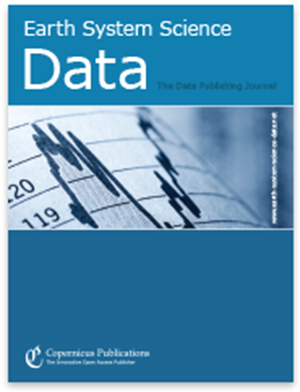Visibility-derived aerosol optical depth over global land from 1959 to 2021
IF 11.2
1区 地球科学
Q1 GEOSCIENCES, MULTIDISCIPLINARY
引用次数: 0
Abstract
Abstract. Long-term and high spatial resolution aerosol optical depth (AOD) data are essential for climate change detection and attribution. Global ground-based AOD observations are sparsely distributed, and satellite AOD retrievals have a low temporal frequency as well low accuracy before 2000 over land. In this study, AOD at 550 nm is derived from visibility observations collected at more than 5000 meteorological stations over global land regions from 1959 to 2021. The AOD retrievals (550 nm) of the Moderate Resolution Imaging Spectroradiometer (MODIS) on board the Aqua Earth observation satellite are used to train the machine learning model, and the ERA5 reanalysis boundary layer height is used to convert the surface visibility to AOD. Comparisons with an independent dataset (AERONET ground-based observations) show that the predicted AOD has a correlation coefficient of 0.55 at the daily scale. The correlation coefficients are higher at monthly and annual scales, which are 0.61 and 0.65, respectively. The evaluation shows consistent predictive ability prior to 2000, with correlation coefficients of 0.54, 0.66, and 0.66 at the daily, monthly, and annual scales, respectively. Due to the small number and sparse visibility stations prior to 1980, the global and regional analysis in this study is from 1980 to 2021. From 1980 to 2021, the mean visibility-derived AOD values over global land areas, the Northern Hemisphere, and the Southern Hemisphere are 0.177, 0.178, and 0.175, with a trend of −0.0029 per 10 years, −0.0030 per 10 years, and −0.0021 per 10 years from 1980 to 2021. The regional means (trends) of AOD are 0.181 (−0.0096 per 10 years), 0.163 (−0.0026 per 10 years), 0.146 (−0.0017 per 10 years), 0.165 (−0.0027 per 10 years), 0.198 (−0.0075 per 10 years), 0.281 (−0.0062 per 10 years), 0.182 (−0.0016 per 10 years), 0.133 (−0.0028 per 10 years), 0.222 (0.0007 per 10 years), 0.244 (−0.0009 per 10 years), 0.241 (0.0130 per 10 years), and 0.254 (0.0119 per 10 years) in Eastern Europe, Western Europe, Western North America, Eastern North America, Central South America, Western Africa, Southern Africa, Australia, Southeast Asia, Northeast Asia, Eastern China, and India, respectively. However, the trends decrease significantly in Eastern China (−0.0572 per 10 years) and Northeast Asia (−0.0213 per 10 years) after 2014, with the larger increasing trend found after 2005 in India (0.0446 per 10 years). The visibility-derived daily AOD dataset at 5032 stations over global land from 1959 to 2021 is available from the National Tibetan Plateau/Third Pole Environment Data Center (https://doi.org/10.11888/Atmos.tpdc.300822) (Hao et al., 2023).1959 年至 2021 年全球陆地能见度气溶胶光学深度
摘要。长期和高空间分辨率的气溶胶光学深度(AOD)数据对于气候变化探测和归因至关重要。全球地面气溶胶光学深度观测数据分布稀少,卫星气溶胶光学深度检索的时间频率较低,2000 年以前陆地气溶胶光学深度检索的精度也较低。在这项研究中,550 nm 波长的 AOD 是根据 1959 年至 2021 年期间在全球陆地地区 5000 多个气象站收集的能见度观测数据得出的。利用 Aqua 地球观测卫星上的中分辨率成像分光仪(MODIS)的 AOD(550 nm)检索结果来训练机器学习模型,并利用ERA5 再分析边界层高度将地表能见度转换为 AOD。与独立数据集(AERONET 地面观测数据)的比较显示,预测的 AOD 日相关系数为 0.55。月尺度和年尺度的相关系数更高,分别为 0.61 和 0.65。评估结果表明,2000 年以前的预测能力是一致的,日、月和年尺度的相关系数分别为 0.54、0.66 和 0.66。由于 1980 年以前的能见度观测站数量少且稀疏,本研究的全球和区域分析时间为 1980 年至 2021 年。从 1980 年到 2021 年,全球陆地、北半球和南半球的能见度衍生 AOD 平均值分别为 0.177、0.178 和 0.175,1980 年到 2021 年的趋势分别为每 10 年-0.0029、每 10 年-0.0030 和每 10 年-0.0021。AOD 的区域均值(趋势)分别为 0.181(每 10 年-0.0096)、0.163(每 10 年-0.0026)、0.146(每 10 年-0.0017)、0.165(每 10 年-0.0027)、0.198 (-0.0075 per 10 years), 0.281 (-0.0062 per 10 years), 0.182 (-0.0016 per 10 years), 0.133 (-0.0028 per 10 years), 0.222 (0.0007 per 10 years), 0.东欧、西欧、北美西部、北美东部、南美中部、非洲西部、非洲南部、澳大利亚、东南亚、东北亚、中国东部和印度分别为 0.244(每 10 年-0.0009)、0.241(每 10 年 0.0130)和 0.254(每 10 年 0.0119)。然而,2014 年之后,中国东部(每 10 年-0.0572)和东北亚(每 10 年-0.0213)的趋势明显下降,2005 年之后,印度(每 10 年 0.0446)的上升趋势更大。国家青藏高原/第三极环境数据中心(https://doi.org/10.11888/Atmos.tpdc.300822)提供了从 1959 年到 2021 年全球陆地 5032 个站点的能见度日 AOD 数据集(Hao 等,2023 年)。
本文章由计算机程序翻译,如有差异,请以英文原文为准。
求助全文
约1分钟内获得全文
求助全文
来源期刊

Earth System Science Data
GEOSCIENCES, MULTIDISCIPLINARYMETEOROLOGY-METEOROLOGY & ATMOSPHERIC SCIENCES
CiteScore
18.00
自引率
5.30%
发文量
231
审稿时长
35 weeks
期刊介绍:
Earth System Science Data (ESSD) is an international, interdisciplinary journal that publishes articles on original research data in order to promote the reuse of high-quality data in the field of Earth system sciences. The journal welcomes submissions of original data or data collections that meet the required quality standards and have the potential to contribute to the goals of the journal. It includes sections dedicated to regular-length articles, brief communications (such as updates to existing data sets), commentaries, review articles, and special issues. ESSD is abstracted and indexed in several databases, including Science Citation Index Expanded, Current Contents/PCE, Scopus, ADS, CLOCKSS, CNKI, DOAJ, EBSCO, Gale/Cengage, GoOA (CAS), and Google Scholar, among others.
文献相关原料
| 公司名称 | 产品信息 | 采购帮参考价格 |
|---|
 求助内容:
求助内容: 应助结果提醒方式:
应助结果提醒方式:


